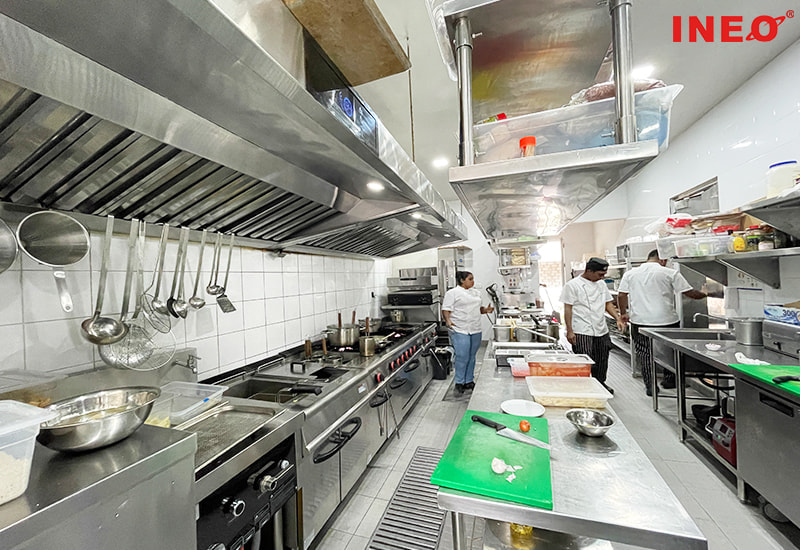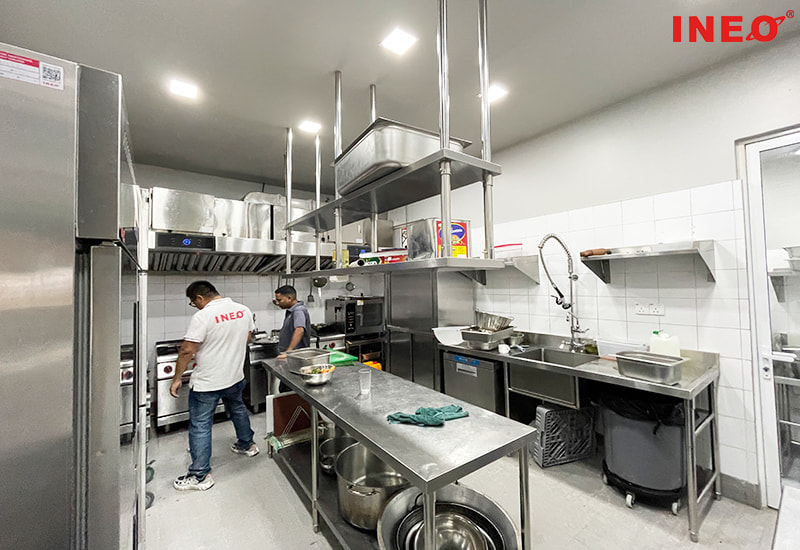In an industrial kitchen, the proper setup of equipment and workstations is crucial for ensuring smooth operations and efficient workflow. This section will discuss the key considerations and best practices for setting up this area in your kitchen.


Choosing the right equipment is essential for a functional and productive industrial kitchen. Consider the specific needs of your menu and the volume of food you will be preparing. Invest in high-quality, durable equipment that is designed for commercial use. Look for energy-efficient options to reduce utility costs.
Some essential equipment to consider includes:
Cooking Equipment: Select stoves, ovens, grills, and fryers that can handle the demands of your menu. Ensure they are properly installed and have adequate ventilation.
Food preparation stations: Set up dedicated stations for cutting, chopping, and mixing. Equip these stations with the necessary tools such as cutting boards, knives, mixers, and food processors.
Storage and refrigeration: Choose commercial-grade refrigerators and freezers that provide ample storage space for perishable ingredients. Consider separate storage areas for dry goods, refrigerated items, and frozen goods.
Dishwasher and cleaning equipment: Install a reliable dishwasher and provide sufficient space for cleaning and sanitizing dishes, utensils, and kitchen equipment.

The layout of workstations in your industrial kitchen should be designed to optimize efficiency and minimize movement. Consider the flow of tasks from food preparation to cooking and plating. Arrange workstations in a logical sequence that allows for easy access to equipment and ingredients.
Some tips for workstation layout include:
Create distinct zones for different tasks, such as food preparation, cooking, and plating.
Ensure workstations are equipped with the necessary tools and supplies within easy reach.
Provide sufficient counter space for food preparation and assembly.
Arrange workstations to minimize cross-traffic and promote a smooth workflow.


Safety should be a top priority when setting up equipment and workstations in your industrial kitchen. Ensure that equipment is properly installed and maintained to prevent accidents and injuries. Consider ergonomic factors to promote the comfort and well-being of your kitchen staff.
Some safety and ergonomic considerations include:
Proper ventilation and exhaust systems to remove heat, smoke, and odors from the kitchen.
Adequate lighting in work areas to ensure clear visibility.
Non-slip flooring to prevent slips and falls.
Ergonomic design of workstations and equipment to reduce strain and fatigue.
By carefully selecting equipment and designing efficient workstations, you can create a well-equipped and productive industrial kitchen. Prioritize safety, functionality, and ergonomics to provide a comfortable and efficient working environment for your kitchen staff.
When setting up an industrial kitchen, one of the key areas that require careful consideration is storage and organization. Proper storage and organization systems are essential for maintaining efficiency, maximizing space, and ensuring food safety. Here are some important factors to consider when setting up this crucial area in your kitchen.
Storage Space & Cold Room : Start by assessing your storage needs based on the volume and types of ingredients and supplies you will be handling. Consider the different categories of items that need storage, such as dry goods, perishables, and cleaning supplies. Allocate sufficient space for each category, taking into account factors like accessibility, temperature control, and shelf life requirements.
Shelving and Racking: Invest in sturdy and adjustable shelving and racking systems that can accommodate your storage needs. Optimize vertical space by using tall shelves and racks, and make sure they are easily accessible for staff members. Consider using wire shelves for better air circulation and to prevent dust accumulation.
Labeling and Organization: Implement a labeling system to ensure proper inventory management and easy identification of items. Label shelves, bins, and containers with clear and descriptive labels, including the date of receipt or expiration. This will help prevent food spoilage and minimize waste. Additionally, establish a system for rotating stock to ensure that older items are used first (First In, First Out).
Food Safety and Hygiene: Proper storage and organization play a crucial role in maintaining food safety and hygiene standards. Store raw and cooked foods separately to prevent cross-contamination. Use sealed containers or food-grade storage bags to protect perishable items. Regularly clean and sanitize storage areas to prevent the growth of bacteria and other contaminants.
Inventory Management: Implement an inventory management system to keep track of stock levels and ensure timely replenishment. This can help prevent shortages or overstocking, minimize waste, and optimize ordering processes. Consider using digital tools or software that can automate inventory tracking and provide real-time data for efficient management.
By paying attention to storage and organization in your industrial kitchen, you can create a well-structured and efficient workspace. This will not only enhance productivity but also contribute to the overall safety and success of your food service operation. Remember to regularly review and update your storage systems to adapt to changing needs and industry trends.
Keywords: industrial kitchen
Originally published 15 Jul 2025, updated 15 Jul 2025.
Get a Project Quote
Our representative will contact you soon